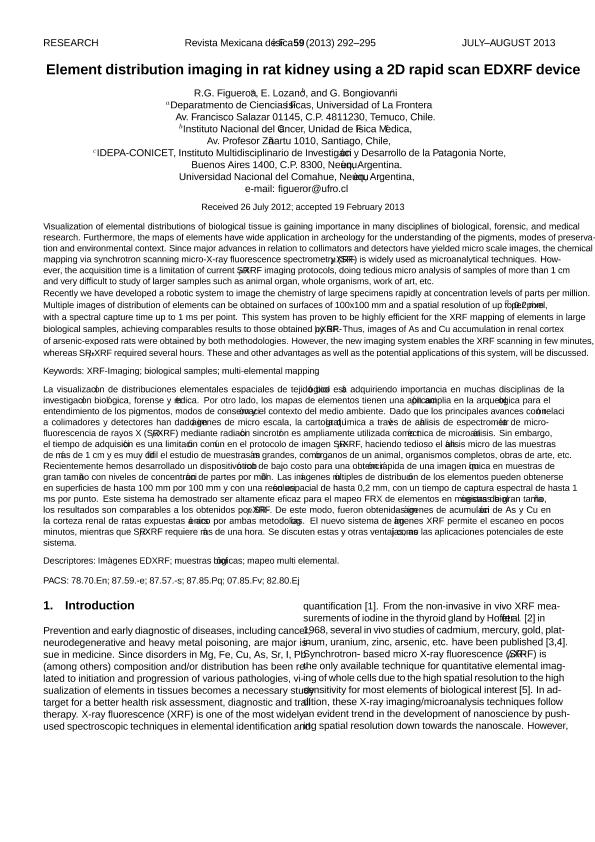Mostrar el registro sencillo del ítem
dc.contributor.author
Figueroa, Rodolfo
dc.contributor.author
Lozano, E.
dc.contributor.author
Bongiovanni, Guillermina Azucena

dc.date.available
2017-06-21T20:51:15Z
dc.date.issued
2013-06
dc.identifier.citation
Figueroa, Rodolfo; Lozano, E.; Bongiovanni, Guillermina Azucena; Element distribution imaging in rat kidney using a 2D rapid scan EDXRF device; Soc Mexicana Fisica; Revista Mexicana de Física; 59; 6-2013; 262-266
dc.identifier.issn
0035-001X
dc.identifier.uri
http://hdl.handle.net/11336/18598
dc.description.abstract
Visualization of elemental distributions of biological tissue is gaining importance in many disciplines of biological, forensic, and medical research. On the other hand, the mapping of elements has wider application to the archaeological, to understanding pigments, modes of preservation, and environmental context. Since major advances in relation to collimators and detectors have yielded micro scale images, the chemical mapping via synchrotron scanning micro-X-ray fluorescence spectrometry (SR-µXRF) is widely used as microanalytical techniques. However, the acquisition time is a limitation of current SR-µXRF imaging protocols, doing tedious micro analysis of samples of more than 1 cm and very difficult to study of larger samples such as animal organ, whole organisms, work of art, etc. Recently we have developed a robotic system to image the chemistry of large specimens rapidly at concentration levels of parts per million. Multiple images of distribution of elements can be obtained on surfaces of 100x100 mm and a spatial resolution of up to 0.2 mm2 per pixel, with a spectral capture time up to 1 ms per point. This system has proven to be highly efficient for the XRF mapping of elements in large biological samples, achieving comparables results to those obtained by SR-μXRF. Thus, images of As and Cu accumulation in renal cortex of arsenic-exposed rats were obtained by both methodologies. However, the new imaging system enables the XRF scanning in few minutes, whereas SR-μXRF required several hours. These and other advantages as well as the potential applications of this system, will be discussed.
dc.format
application/pdf
dc.language.iso
eng
dc.publisher
Soc Mexicana Fisica

dc.rights
info:eu-repo/semantics/openAccess
dc.rights.uri
https://creativecommons.org/licenses/by-nc-sa/2.5/ar/
dc.subject
Xrf-Imaging
dc.subject
Biological Samples
dc.subject
Multi-Elemental Mapping
dc.subject.classification
Tecnología de Laboratorios Médicos

dc.subject.classification
Ingeniería Médica

dc.subject.classification
INGENIERÍAS Y TECNOLOGÍAS

dc.title
Element distribution imaging in rat kidney using a 2D rapid scan EDXRF device
dc.type
info:eu-repo/semantics/article

dc.type
info:ar-repo/semantics/artículo
dc.type
info:eu-repo/semantics/publishedVersion

dc.date.updated
2015-04-06T14:29:05Z
dc.journal.volume
59
dc.journal.pagination
262-266
dc.journal.pais
México

dc.journal.ciudad
México
dc.description.fil
Fil: Figueroa, Rodolfo. Universidad de la Frontera; Chile
dc.description.fil
Fil: Lozano, E.. Instituto Nacional del Cancer; Chile
dc.description.fil
Fil: Bongiovanni, Guillermina Azucena. Consejo Nacional de Investigaciones Científicas y Técnicas. Centro Científico Tecnol.conicet - Patagonia Norte. Instituto de Investigación y Des. En Ing. de Procesos, Biotecnología y Energias Alternativas. Idepa - Subsede San Antonio Oeste; Argentina
dc.journal.title
Revista Mexicana de Física

dc.relation.alternativeid
info:eu-repo/semantics/altIdentifier/url/http://rmf.smf.mx/pdf/rmf/59/4/59_4_292.pdf
dc.relation.alternativeid
info:eu-repo/semantics/altIdentifier/url/http://www.scielo.org.mx/scielo.php?script=sci_arttext&pid=S0035-001X2013000400002
Archivos asociados
